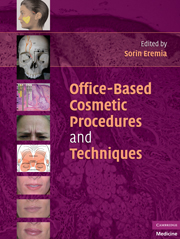Book contents
- Frontmatter
- Contents
- PREFACE
- CONTRIBUTORS
- PART ONE ANATOMY AND THE AGING PROCESS
- PART TWO ANESTHESIA AND SEDATION FOR OFFICE COSMETIC PROCEDURES
- PART THREE FILLERS AND NEUROTOXINS
- Chap. 6 FILLERS: PAST, PRESENT, AND FUTURE
- Chap. 7 HYALURONIC ACID FILLERS: HOW STRUCTURE AFFECTS FUNCTION
- Chap. 8 RESTYLANE: GENERAL CONCEPTS
- Chap. 9 THE RESTYLANE FAMILY OF FILLERS: CANADIAN EXPERIENCE
- Chap. 10 THE JUVÉDERM FAMILY OF FILLERS
- Chap. 11 PURAGEN: A NEW DERMAL FILLER
- Chap. 12 PURAGEN: ASIAN EXPERIENCE
- Chap. 13 REVIEW OF COLLAGEN FILLERS
- Chap. 14 HUMAN AND BOVINE COLLAGEN-BASED FILLERS
- Chap. 15 PORCINE COLLAGEN: EVOLENCE
- Chap. 16 CALCIUM HYDROXYLAPATITE (RADIESSE): A FACIAL PLASTIC SURGEON'S APPROACH
- Chap. 17 CALCIUM HYDROXYLAPATITE (RADIESSE): A DERMASURGEON'S APPROACH
- Chap. 18 CALCIUM HYDROXYLAPATITE FOR HAND VOLUME RESTORATION
- Chap. 19 LONG-LASTING FILLERS: HOW STRUCTURE AFFECTS FUNCTION
- Chap. 20 ACRYLIC PARTICLE–BASED FILLERS: ARTEFILL
- Chap. 21 POLY-L-LACTIC ACID FILLERS
- Chap. 22 POLY-L-LACTIC ACID (SCULPTRA) FOR HAND VOLUME RESTORATION
- Chap. 23 BIOALKAMIDE
- Chap. 24 SILICONE
- Chap. 25 AUTOLOGOUS FAT TRANSFER: AN INTRODUCTION
- Chap. 26 SMALL-VOLUME FAT TRANSFER
- Chap. 27 LARGER-VOLUME FAT TRANSFER
- Chap. 28 FAMI TECHNIQUE AND FAT TRANSFER FOR HAND REJUVENATION
- Chap. 29 ADDING VOLUME TO THE AGING FACE: FAT GRAFTING VERSUS FILLERS AND IMPLANTS IN EUROPE
- Chap. 30 FILLERS: HOW WE DO IT
- Chap. 31 CHOOSING A FILLER
- Chap. 32 FILLER COMPLICATIONS
- Chap. 33 NEUROTOXINS: PAST, PRESENT, AND FUTURE
- Chap. 34 BOTOX: HOW WE DO IT
- Chap. 35 COSMETIC BOTOX: HOW WE DO IT
- Chap. 36 BOTOX: BEYOND THE BASICS
- Chap. 37 BOTOX FOR HYPERHIDROSIS
- Chap. 38 DYSPORT
- Chap. 39 NEUROTOXIN ALTERNATIVE: RADIOFREQUENCY CORRUGATOR DENERVATION
- Chap. 40 FILLERS AND NEUROTOXINS IN ASIA
- Chap. 41 FILLERS AND NEUROTOXINS IN SOUTH AMERICA
- PART FOUR COSMETIC APPLICATIONS OF LIGHT, RADIOFREQUENCY, AND ULTRASOUND ENERGY
- PART FIVE OTHER PROCEDURES
- INDEX
Chap. 30 - FILLERS: HOW WE DO IT
from PART THREE - FILLERS AND NEUROTOXINS
Published online by Cambridge University Press: 06 July 2010
- Frontmatter
- Contents
- PREFACE
- CONTRIBUTORS
- PART ONE ANATOMY AND THE AGING PROCESS
- PART TWO ANESTHESIA AND SEDATION FOR OFFICE COSMETIC PROCEDURES
- PART THREE FILLERS AND NEUROTOXINS
- Chap. 6 FILLERS: PAST, PRESENT, AND FUTURE
- Chap. 7 HYALURONIC ACID FILLERS: HOW STRUCTURE AFFECTS FUNCTION
- Chap. 8 RESTYLANE: GENERAL CONCEPTS
- Chap. 9 THE RESTYLANE FAMILY OF FILLERS: CANADIAN EXPERIENCE
- Chap. 10 THE JUVÉDERM FAMILY OF FILLERS
- Chap. 11 PURAGEN: A NEW DERMAL FILLER
- Chap. 12 PURAGEN: ASIAN EXPERIENCE
- Chap. 13 REVIEW OF COLLAGEN FILLERS
- Chap. 14 HUMAN AND BOVINE COLLAGEN-BASED FILLERS
- Chap. 15 PORCINE COLLAGEN: EVOLENCE
- Chap. 16 CALCIUM HYDROXYLAPATITE (RADIESSE): A FACIAL PLASTIC SURGEON'S APPROACH
- Chap. 17 CALCIUM HYDROXYLAPATITE (RADIESSE): A DERMASURGEON'S APPROACH
- Chap. 18 CALCIUM HYDROXYLAPATITE FOR HAND VOLUME RESTORATION
- Chap. 19 LONG-LASTING FILLERS: HOW STRUCTURE AFFECTS FUNCTION
- Chap. 20 ACRYLIC PARTICLE–BASED FILLERS: ARTEFILL
- Chap. 21 POLY-L-LACTIC ACID FILLERS
- Chap. 22 POLY-L-LACTIC ACID (SCULPTRA) FOR HAND VOLUME RESTORATION
- Chap. 23 BIOALKAMIDE
- Chap. 24 SILICONE
- Chap. 25 AUTOLOGOUS FAT TRANSFER: AN INTRODUCTION
- Chap. 26 SMALL-VOLUME FAT TRANSFER
- Chap. 27 LARGER-VOLUME FAT TRANSFER
- Chap. 28 FAMI TECHNIQUE AND FAT TRANSFER FOR HAND REJUVENATION
- Chap. 29 ADDING VOLUME TO THE AGING FACE: FAT GRAFTING VERSUS FILLERS AND IMPLANTS IN EUROPE
- Chap. 30 FILLERS: HOW WE DO IT
- Chap. 31 CHOOSING A FILLER
- Chap. 32 FILLER COMPLICATIONS
- Chap. 33 NEUROTOXINS: PAST, PRESENT, AND FUTURE
- Chap. 34 BOTOX: HOW WE DO IT
- Chap. 35 COSMETIC BOTOX: HOW WE DO IT
- Chap. 36 BOTOX: BEYOND THE BASICS
- Chap. 37 BOTOX FOR HYPERHIDROSIS
- Chap. 38 DYSPORT
- Chap. 39 NEUROTOXIN ALTERNATIVE: RADIOFREQUENCY CORRUGATOR DENERVATION
- Chap. 40 FILLERS AND NEUROTOXINS IN ASIA
- Chap. 41 FILLERS AND NEUROTOXINS IN SOUTH AMERICA
- PART FOUR COSMETIC APPLICATIONS OF LIGHT, RADIOFREQUENCY, AND ULTRASOUND ENERGY
- PART FIVE OTHER PROCEDURES
- INDEX
Summary
Injectable fillers have become an integral part of nonsurgical enhancement of the face and body. A wide variety of fillers are currently available in the United States, and even more are available worldwide. In the last few years, there has been an explosion in the use of injectable fillers. Due to the specific nature of each filler material, each one has different applications, advantages, and disadvantages. In this chapter, we will be discussing all of the available fillers and the various techniques we employ during treatment of the face and body.
MATERIALS AND MECHANISMS OF ACTION
The mechanism of action that all injectable fillers share is the augmentation of an existing area to a desired target volume. There are permanent and semipermanent fillers. In the nonpermanent group are short-acting, intermediate, and long-acting fillers, depending on the length of duration of the product.
The collagen-based fillers include bovine collagen (Zyplast, Zyderm) and recombinant human collagen (Cosmoplast, Cosmoderm), which are in the short-acting category. The older bovine collagen fillers require a skin test prior to use, whereas the newer human collagen fillers do not. Collagen-based fillers are injected into the dermis, in the superficial and deep planes, depending on which one is being used. These fillers are manufactured with lidocaine, making the injections easier to tolerate. Collagen-based fillers can be used anywhere on the face but are most commonly used in the perioral area, especially the nasolabial folds and lips. Collagen-based fillers are injected through a 30-gauge needle.
- Type
- Chapter
- Information
- Office-Based Cosmetic Procedures and Techniques , pp. 129 - 132Publisher: Cambridge University PressPrint publication year: 2010



